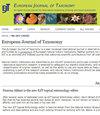The genus Begonia (Begoniaceae) in Peru
IF 1.3
3区 生物学
Q3 ENTOMOLOGY
引用次数: 2
Abstract
We provide a floristic account for the Begoniaceae of Peru. The family is represented in Peru by 76 species, which are all members of the genus Begonia and represent eighteen sections. Twelve new species are described: B. condorensis Jara & Moonlight sp. nov., B. deltoides Moonlight sp. nov., B. huancabambae Moonlight sp. nov., B. imbrexiformis Moonlight sp. nov., B. longinqua Moonlight sp. nov., B. longitepala Moonlight sp. nov., B. nunezii Moonlight sp. nov., B. occultata J.P.Allen & Moonlight sp. nov., B. pedemontana Moonlight sp. nov., B. serratistipula Moonlight sp. nov., B. vargasii Moonlight sp. nov. and B. yuracyacuensis Moonlight sp. nov. We also provide four new records for the country: B. andina Rusby, B. brandbygeana L.B.Sm. & Wassh., B. neoharlingii L.B.Sm. & Wassh. and B. unilateralis Rusby. We provide an identification key to all species. The ecology, distribution, and conservation status of all Peruvian Begonia species are discussed, including provisional IUCN threat assessments. Most species are illustrated by either historical illustrations, contemporary photographic plates, or line drawings. Twenty-six names are newly synonymised including fifteen previously accepted species, and we designate eighty-three lectotypes, four neotypes, and four epitypes.秘鲁秋海棠属(秋海棠科)
我们提供了秘鲁秋海棠科的植物区系描述。该科在秘鲁有76种,它们都是秋海棠属的成员,代表了18个部分。描述了12个新种:B.condorensis Jara&Moonlight sp.nov.,B.deltoides Moonlight sp.nov.、B.huancababae Moonlight sp.nov.和B.imbrexiformis Moonlight sp.nov.。,B.longinqua Moonlight sp.nov..,B.longitepala Moonlight P.nov.,B.nunezii Moonlight s.nov.,B.occlusta J.P.Allen&Moonlightsp.nov..,B.pedemotana Moonlightsp.nov。,B.serratistipula Moonlight sp.nov.、B.vargasii Moonlight sp.nov.和B.yuracyacuensis Moonlight sp.nov.我们还为该国提供了四个新记录:B.andina Rusby、B.brandbygeana L.B.Sm和Wassh。,B.neohallingii L.B.S.&Wassh。B.单边主义。我们为所有物种提供识别密钥。讨论了所有秘鲁秋海棠物种的生态、分布和保护状况,包括国际自然保护联盟的临时威胁评估。大多数物种都用历史插图、当代摄影板或线条画来说明。26个名称是新的同义词,包括15个以前接受的物种,我们指定了83个选型、4个新型和4个表型。
本文章由计算机程序翻译,如有差异,请以英文原文为准。
求助全文
约1分钟内获得全文
求助全文
来源期刊

European journal of taxonomy
ZOOLOGY-
CiteScore
2.30
自引率
8.30%
发文量
173
审稿时长
29 weeks
期刊介绍:
EJT is a fully refereed, international, fully electronic Open Access journal in descriptive taxonomy, covering subjects in zoology, entomology, botany (in its broadest sense), and palaeontology. EJT-papers must be original and adhere to high scientific (content) and technical (language, artwork, etc.) standards. Manuscripts that are clearly substandard in either of these categories will not be sent out for review. EJT is supported by a consortium of European Natural History Institutes, but its scope is global. Both authorship and geographical region of study need not be European. Authors are, however, strongly encouraged to involve European Natural History collections by consulting material or by depositing specimens (e.g. types and figured material) related to their published paper in the collection of a European Natural History Institute.
 求助内容:
求助内容: 应助结果提醒方式:
应助结果提醒方式:


